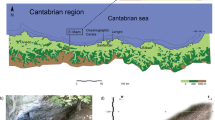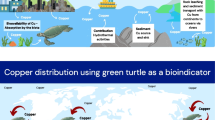Abstract
Based on an analysis of the gonads, as well as the size composition and abundance of larvae in plankton, we determined the seasonal and long-term dynamics of the reproduction of the mussel Mytilus coruscus in Amursky Bay (Peter the Great Bay, Sea of Japan). Mussel gonads were in a mature condition in late July-early August; the spawning season continued from mid-August to mid-September. The larvae of this species occurred in plankton from June to September, under surface water temperatures of 14.5–23.5°C. The density of larvae in different years varied from 350 to 4500 ind/m3. Two peaks of larval abundance were observed annually, in June and September. The first peak was apparently provided by allochthonous larvae, the second, by larvae of the local population. The high density of larvae of M. coruscus in the plankton of Peter the Great Bay enabled us to consider this species as a potential object for mariculture.
Similar content being viewed by others
References
Golikov, A.N. and Skarlato, O.A., Molluscs of the Posyet Bay (Sea of Japan) and Their Ecology, Tr. ZIN AN SSSR, 1967, vol. 42, pp. 50–152.
Evseyev, G.A. and Kolotukhina, N.K., Comparative Morphology and Taxonomy Problems of Pelagic Larvae of the Mytilidae Family (Mollusca: Bivalvia) from the Peter the Great Bay, Sea of Japan, Bull. Dal’nevost. malakol. Obshest., 2008, iss. 12, pp. 5–41.
Zhirmunsky, A.V., Comparative Study of Cell Thermostability of Marine Invertebrates in Relation to Their Geographical Distribution and Ecology, Kletka i temperatura sredy (Cell and Environmental Temperature), Moscow, Leningrad: Nauka, 1964, pp. 142–150.
Ivashchenko, E.A., Water Circulation in the Peter the Great Bay, Geograficheskie issledovaniya shel’fa dal’nevostochnykh morei (Geographical Studies of the Shelf of Far East Seas), Vladivostok: Izd. DVGU, 1993, pp. 31–61.
Kulikova, V.A. and Kolotukhina, N.K., Pelagicheskie lichinki dvustvorchatykh mollyuskov Yaponskogo morya. Metody. Morfologiya. Identifikatsiya: Preprint (Pelagic Larvae of Bivalves of Sea of Japan. Methods. Morphology. Identification: Preprint), Vladivostok: Inst. Biol. Morya DVO AN SSSR, 1989, no. 21.
Kulikova, V.A., Korn, O.M., Kolotukhina, N.K., and Radovets, A.V., Meroplankton of Amursky and Ussuriisky Bays, Sea of Japan, X s’ezd Gidrobiol. Obsh. pri RAN: Tez. dokl. (g. Vladivostok, 28 sentyabrya — 2 oktyabrya 2009 g.) (X Congr. Gidrobiol. Soc. RAN: Abstracts. (Vladivostok, September 28–October 2, 2009)), Vladivostok: Dal’nauka, 2009, pp. 222–223.
Lotsiya severo-zapadnogo berega Yaponskogo moray (The Pilot of the Northwest Coast of Sea of Japan), SPb: 1996.
Materialy po biologicheskomu obosnovaniyu dlya vosstanovleniya promyslovykh skoplenii bespozvonochnykh v zalive Petra Velikogo (Materials on the Biological Basis for Restoration of Commercial Aggregations of Invertebrates in the Peter the Great Bay), Vladivostok: Arkhiv TINRO, 1992, no. 21349.
Rumyantsev, A.I., Vzveshennye veschestva, jiry v vode Amurskogo zaliva. Izuchenie zagryazneniya morskoi sredy i biologicheskikh resursov dal’nevostochnykh morei (Suspended Matter, Fats in the Water of Amursky Bay. A Study of Marine Environment Pollution and the Biological Resources of Far East Seas), Vladivostok: Arkhiv TINRO, 1974, no. 14 302.
Savelyeva, N.I., Sozdanie regional’noi sistemy nablyudenii i provedenie issledovanii dinamiki vod i protsessov peremeshivaniya v zalive Petra Velikogo v interesakh narodnogo hozyaistva. Predostavlenie obschei skhemy dinamiki vod i protsessov peremeshivaniya v zalive Petra Velikogo (Establishment of Regional Monitoring System and Research of Water Dynamics and Mixing Processes in the Peter the Great Bay for Interests of Economy. A Provision of the General Scheme of Water Dynamics and Mixing Processes in the Peter the Great Bay), Vladivostok: Arkhiv DVNIGMI, T.R. 00192001484, 1996.
Selin, N.I., Size-Age Structure and Growth of the Mussel Mytilus coruscus in Peter the Great Bay, Sea of Japan, Biol. Morya, 1988, vol. 14, no. 5, pp. 45–49.
Selin, N.I., Brykov, V.A., Denisov. V.A., et al., Otsenka perspektivnosti akvatorii dlya promysla i razvedeniya morskikh bespozvonochnykh. Dep. v VINITI. 19.08.92. 2663-V92 (Assessment of Advances of an Area for Fishing and Breeding of Marine Invertebrates. Dep. VINITI. 08/19/92. no. 2663-B92), Vladivostok, 1992.
Selin, N.I. and Vekhova, E.E., Morphology of the Bivalve Mollusks Crenomytilus grayanus and Mytilus coruscus in Relation to Their Spatial Distribution in the Upper Subtidal Zone, Russian Journal of Marine Biology, 2002, vol. 28, no. 3, pp. 213–217.
Selin, N.I. and Vekhova, E.E., Effects of Environmental Factors on Byssal Thread Formation in Some Members of the Family Mytilidae from the Sea of Japan, Russian Journal of Marine Biology, 2004, vol. 30, no. 5, pp. 306–313.
Semenikhina, O.Ya. and Kolotukhina, N.K., Morphology of Mytilus coruscus Larvae (Bivalvia: Mytilidae), Zool. Zhurn., 2001, vol. 80, no. 12, pp. 1518–1521.
Skarlato, O.A., Dvustvorchatye mollyuski umerennykh vod severo-zapadnoi chasti Tikhogo okeana (Bivalves of Temperate Waters of the Northwest Pacific), Leningrad: Nauka, 1981.
Lee, Il-Ho, Choi, Jin-Woo, Lee, Ki-Young, and Chung, Ee-Young, Reproduction of the Hard Shelled Mussel Mytilus coruscus in Western Korea, The 10th Int. Congr. on Medical and Applied Malacology. Busan, Korea. 25–29 August 2009, p. 140.
Shen, Y. and Teng, B., Genetic Analysis of Cultured and Wild Populations of Mytilus coruscus Based on Mitochondrial DNA, Zool. Res., 2009, vol. 30, no. 3, pp. 240–246.
Shin, Yun-Kyung and Wi, Chong-Hwan, Effects of Temperature and Salinity on Survival and Metabolism of the Hard Shelled Mussel Mytilus coruscus (Bivalvia: Mytilidae), J. Aquacult., 2004, vol. 17, no. 2, pp. 103–108.
Wang, Z., Fauna Sinica. Phylum Mollusca. Order Mytiloida. Beijing: Science Press.1997.
Yoon, Gil Ha, Aquaculture in Korea, Aquacult. News, 2008, vol. 34, pp. 16–17.
Author information
Authors and Affiliations
Corresponding author
Additional information
Original Russian Text © V.A. Kulikova, S.A. Lyashenko, N.K. Kolotukhina, 2011, published in Biologiya Morya.
Rights and permissions
About this article
Cite this article
Kulikova, V.A., Lyashenko, S.A. & Kolotukhina, N.K. Seasonal and interannual dynamics of larval abundance of Mytilus coruscus Gould, 1861 (Bivalvia: Mytilidae) in Amursky Bay (Peter the Great Bay, Sea of Japan). Russ J Mar Biol 37, 342–347 (2011). https://doi.org/10.1134/S1063074011050087
Received:
Published:
Issue Date:
DOI: https://doi.org/10.1134/S1063074011050087




